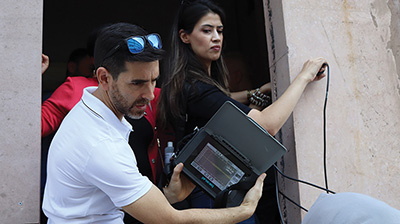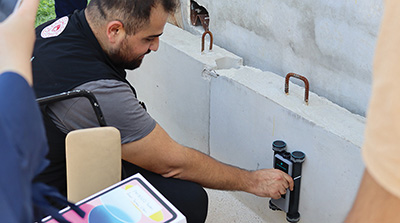From disaster recovery to saving cultural heritage: IAEA boosts assistance to countries in non-destructive testing
30/06/2025
Every minute of every day, an earthquake occurs somewhere in the world. Of the half a million earthquakes that happen each year, around 100,000 can be felt and around 100 result in significant damage. These events can profoundly impact people and also cities, disrupting road networks and threatening vital infrastructure such as dams. To help countries better prepare for these natural disasters, the International Atomic Energy Agency (IAEA) has recently increased its services in non-destructive testing (NDT), by opening a new training centre and by issuing guidelines, aimed at building capacity in this life-saving technique.
 | ||
| An IAEA expert demonstrates the use of an ultrasonic pulse velocity (UPV) tester to examine the structural integrity of a concrete wall during a training course held for Turkish disaster management teams in Ankara, Türkiye, August 2024 Photo courtesy of Directorate General of Construction Works, Türkiye |
NDT is used to evaluate the integrity of industrial facilities, structures and components without damaging the part being inspected and such techniques have proven essential in assessing infrastructure safety, especially in the wake of disasters. After the earthquakes in Türkiye, Syria and Ecuador in 2023 and the 2020 explosion in Beirut, Lebanon, for instance, NDT played a key role in evaluating buildings and structures, helping protect both civilians and rescue teams in precarious situations.
Responding to increasing demand from countries for assistance, the IAEA has built, from scratch, an NDT Centre at its laboratories in Seibersdorf, Austria, to provide hands-on training and support emergency response efforts.
 | ||
| A Turkish disaster management expert examines steel embedded inside concrete during an IAEA national training course held in Ankara, Türkiye, August 2024 Photo courtesy of Directorate General of Construction Works, Türkiye |
“To have the possibility to quickly move portable NDT equipment makes a huge difference in offering timely help to Member States in the aftermath of a disaster,” said Tzanka Kokalova-Wheldon, Director of the IAEA Division of Physical and Chemical Sciences. “It is not just about disaster management,” she added. “NDT helps civil engineers also in prevention and readiness, by improving regular maintenance checks.”
To harmonise the training and certification of engineers, the IAEA has also just published the Guidelines on Training Syllabi in Non-destructive Testing for Civil Engineering (NDT-CE).
As the first of its kind, this publication seeks to ensure global uniformity and harmonisation of NDT-related training programmes for civil engineers.
NDT encompasses a variety of techniques that leverage the interactions of matter with radiation, sound, magnetic fields, electrical currents and testing agents to inspect materials without damaging them. The most used methods include industrial radiography, ultrasonic testing, liquid penetrant inspection and magnetic particle inspection.
Using gamma or X-rays, industrial radiography plays a critical role in creating images that can reveal the safety and quality of civil engineering structures, as bridges, tunnels, dams and buildings are subject to deterioration from environmental stress, including extreme events such as earthquakes. NDT is used extensively to inspect aircraft structures, turbine blades and pressure vessels.
As NDT allows experts to inspect objects without harming them, it also contributes significantly to the field of cultural heritage. NDT techniques enable experts to analyse the internal structures of priceless artefacts, sculptures and historical structures without causing damage, which aids in restoration and conservation efforts.
Innovations and the latest developments in NDT techniques were prominently featured at the Third International Conference on Applications of Radiation Science and Technology (ICARST2025), which gathered hundreds of experts from radiation-related physics, chemistry, materials science, biology and engineering fields in Vienna in April 2025.
Following on from previous conferences in 2017 and 2022, ICARST2025 showcased how radiation sciences have contributed to industrial growth and economic development by providing versatile tools and processes to produce high-quality products in a clean and efficient manner. Participants discussed how these technologies will help achieve the United Nations’ Sustainable Development Goals.
“At a side event on enhancing global collaboration in NDT for disaster recovery enhancement, we highlighted the importance of strong international stakeholder networks in our NDT emergency response plan,” said Hannah Affum, an Industrial Technologist at the IAEA. “We also signed Practical Arrangements with the International Committee for Non-Destructive Testing (ICNDT) for the promotion of increased use of NDT in industry, civil engineering and cultural heritage.”
The International Atomic Energy Agency is the world’s central intergovernmental forum for scientific and technical cooperation in the nuclear field. It works for the safe, secure and peaceful uses of nuclear science and technology, contributing to international peace and security and the United Nations’ Sustainable Development Goals.